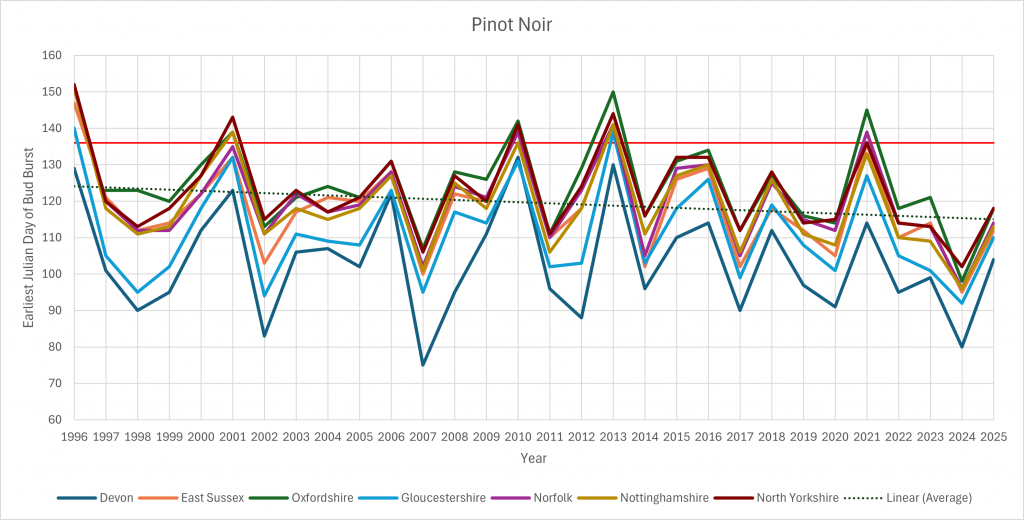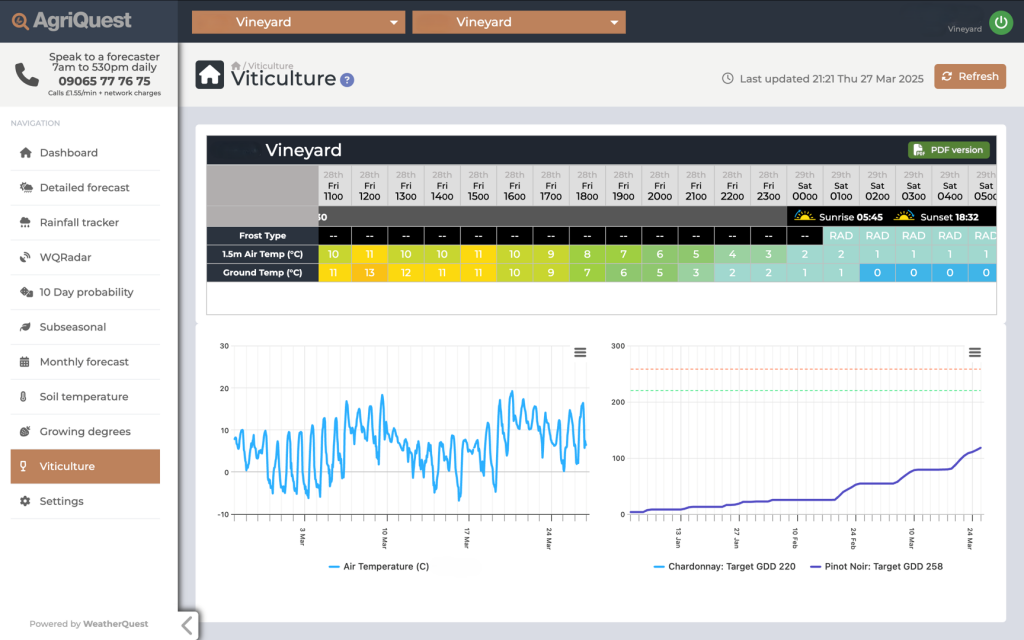Forecasting Frosts And Why It Matters
Budburst leads to a period of vulnerability to springtime frost in the vineyard. Budburst timing varies according to grape variety and to year as a function of Growing Degree Days (GDD). When a frost is forecasted during the budburst period and when vineyard temperature measurements show a convincing trend in that direction, vineyard managers need to rapidly assess which frost mitigation measures may most effectively mitigate the potentially devastating impacts. For this, an understanding of frost type is important.
Radiation Frosts generally involve cold air at the ground surface and significantly warmer air above (a situation also known as a Temperature Inversion). Clear skies and light winds overnight help to encourage the development of such an Inversion and, if the starting temperature in the evening is cool enough, the ground may lose enough energy overnight for a Ground Frost to occur. This may be followed by the potential for a frost in the overlying air too (an Air Frost) as the ground cools the adjacent air above. In these conditions, the overnight ground temperature is usually colder than the air temperature at bud height (typically1m above ground) which in turn is usually colder than the temperature recorded by a typical weather station (usually at 1.5m height). Those temperature differences can commonly be several degrees Celsius, sometimes more.
Advection Frosts, meanwhile, such as those which occurred on the 26th and 27th February 2018 (The Beast from the East), don’t exhibit such significant Temperature Inversions, so lack any natural heat source to mitigate the frost impacts. They are typically associated with a deep layer of cold Polar or Arctic Air, sometimes with strong accompanying winds, and often affect large areas when they occur. Advection Frosts are more difficult to defend against due to the sheer volume of cold air involved – a significant surface heat source is required.
The graph below shows how the start of budburst in Pinot noir has varied in different counties over the last 30 years, based on our budburst model (Day 90 = 31st March, Day 120 = 30th April). Each county here is represented by a specific vineyard, but we can repeat the calculation for your specific location too. The dotted line shows how budburst has been starting progressively earlier, moving forward by 3 days per decade on average. So, although the climate is warming overall, and frost frequency declining, this change in phenology is compensating for this, meaning frost risk remains a significant problem.

As an example, May 15th 2020 (Day 135, the horizontal red line on the graph) saw a very late spring frost event across major vineyard areas. Budburst in Pinot noir that year was estimated to be around Day 105 in East Sussex and Day 115 in Norfolk. But it’s easy to see how much more damaging it could have been if it had happened say in 2016 or 2021, when budburst in these same counties was around Day 130.

So, the first challenge is to be aware when buds are vulnerable, to then have access to site specific vineyard forecasts and finally to be able to distinguish between radiation frosts and advection frosts in order to optimise frost mitigation measures.
This is where our frost forecasting tool, VineBuddy, comes in. VineBuddy provides site-specific bud-height frost forecasts, including Frost Type, helping vineyard managers take timely and well-informed action. Integrated with in-field sensors, VineBuddy takes account of the variations in temperature which naturally occur in the vineyard due to topography, ensuring you’re never caught off guard.

The VineBuddy service consists of an easy-to-use WebApp dashboard, showing the past 30 days of local temperatures, a GDD budburst threshold monitor and 48-hour ahead frost forecasts, with an option to integrate your own within-vineyard weather sensors. The WebApp is complemented by WhatsApp Frost Alerts and the option to call the WeatherQuest Forecast team, when you need to, for peace of mind.

If you would like to find out more, speak to WeatherQuest’s Steve Dorling at the Vineyard Show on 19th November 2025 where Steve is a speaker in the seminar programme. Or visit the Vinescapes stand at the show to express your interest and sign up for a free VineBuddy trial during February 2026. If you can’t make the Vineyard Show, you can also head to the Vinescapes website and complete the VineBuddy form:
